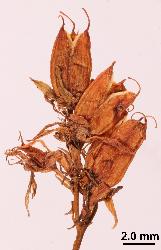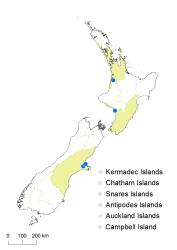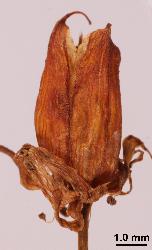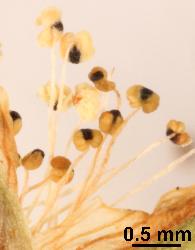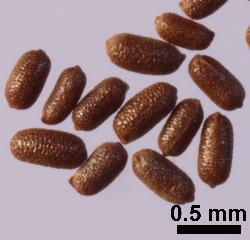- Taxon
- Gallery
- = Hypericum quadrangulum L., Sp. Pl. 785 (1753)
- = Hypericum acutum Moench, Methodus (Moench) 128 (1794) nom. illeg.
Herbaceous perennial, woody stock, sometimes with slender stolons, up to 1 m high. Stems erect, up to 2.8 mm diam., quadrangular, 4-lined, black glands present on lines. Leaves 10.0–35.0 mm long, 4.0–18.0 mm wide, ovate, elliptic or elliptic-oblong, reticulate tertiary veins absent; pellucid glands present; black glands intramarginal; apex subacute, obtuse or rounded; margin entire; base amplexicaul or cordate; sessile. Inflorescence terminal, panicle of cymes, flowers 3–many, corolla 10.0–20.0 mm diam. Pedicels 1.0–7.0 mm long. Bracteoles 2.5–3.4 mm long, 0.4–0.8 mm wide, linear-lanceolate or lanceolate, apex acuminate. Sepals 5, 3.2–5.0 mm long, 0.7–1.3 mm wide, equal, narrowly lanceolate or lanceolate-elliptic; pellucid glands present; black glands present or absent; apex acute or acuminate; margin entire. Petals 6.0–7.5 mm long, 1.5–3.0 mm wide, longer than sepals, elliptic-ovate or elliptic-oblong, pale yellow, black glands present or absent, persistent after anthesis. Stamens in 3 bundles, 30–37, 3.5–6.0 mm long, shorter than petals; anthers 0.5–0.6 mm long, anther gland black. Ovary 2.5–3.0 mm long, 1.0–1.4 mm wide, ovoid. Styles 3, 2.0–2.4 mm long, shorter than ovary. Fruit capsule, 5.0–7.5 mm long, 2.0–4.0 mm wide, ovoid or oblong-ovoid, light brown. Seeds 0.7–0.8 mm long, 0.3–0.4 mm wide, oblong, terete, light brown, apices obtuse or rounded.
Distinguished by quadrangular and 4-lined stems, conspicuous black glands on the stems lines, leaves with intramarginal black glands, lanceolate sepals with an acuminate apex, and the anthers with a prominent black gland.
North Island: Auckland, Southern North Island.
South Island: Canterbury.
Occurs in a variety of wet habitats such as swamps, wetlands, stream banks, and damp pasture, where it often grows amongst sedges and introduced grasses.
Allan (1940, p. 287), as Hypericum acutum. Voucher: CHR 33433, 1941.
Flowering: Dec.–Feb.



